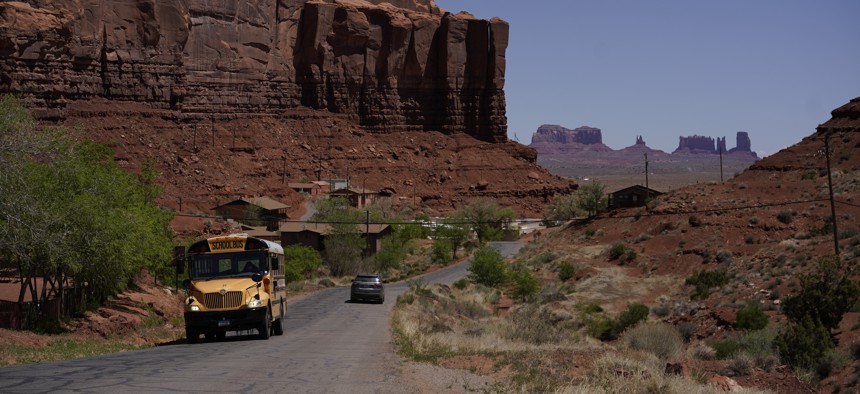Feds Will Reopen Schools on Native American Reservations

A school bus drives through the Navajo Nation in April. AP Photo/Carolyn Kaster
Despite the outsize toll the pandemic has taken on Native American communities, the federal government said that schools on reservations should reopen in September.
The federal agency tasked with the oversight of some schools on Native American reservations announced that officials intend to reopen 53 schools they manage in 10 states to the “maximum extent possible” on September 16.
The Bureau of Indian Education, part of the U.S. Department of the Interior, last week sent out a memo to bureau-operated schools saying that virtual-only learning environments would only be allowed if an outbreak occurred at the school that required a schoolwide shutdown. Though families can opt for distance learning if they want, teachers will be required to teach from the classroom, according to the memo, which was first obtained by NBC News.
The news has been met with alarm by the union that represents Bureau of Indian Education employees.
“I am very concerned, and so are the majority of employees I’m hearing from,” said Sue Parton, president of the Federation of Indian Service Employees. “Many Native Americans depend on [the Indian Health Service] for healthcare. That has historically been underfunded and this pandemic is highlighting that.”
Native American reservations have been some of the hardest hit locations during the coronavirus pandemic, becoming early hotspots for the virus in May and June. The Navajo Nation at one point had more positive cases per capita than any state in the country, while the disease has torn through other tribes, such as the Mississippi Band of Choctaw Indians and the White Mountain Apache tribe.
Reopening schools on reservations could be more dangerous not only because cases are flourishing there, but also because of the high instance of diseases among the general public that can cause complications and make the coronavirus more deadly, including diabetes, asthma, and high blood pressure. Native Americans are more than five times more likely to be hospitalized from the virus than white people.
To make matters more concerning, reservations are often located in rural areas with little access to healthcare and hospitals. Indian Health Service facilities also lack the Intensive Care Unit capacity to handle a surge in cases; the 24 IHS-run healthcare centers across the country share just 33 ICU beds.
These factors combined mean that “schools have no ability to address the health concerns of students and staff,” Parton said.
The Bureau of Indian Education in their reopening guidelines ask schools to take precautionary measures to mitigate the spread of the virus, including making hand sanitizer available, breaking classes into smaller groups, spacing desks at least six feet apart, and deep cleaning classrooms and school buses.
The Bureau acknowledged that “many educators in BIE schools may be vulnerable to Covid-19, raising questions about how to protect them, whether they will want to work in schools next year, and how to respond to any resultant personnel shortages.” They promised to “work with the union to revisit aspects of its agreement to help schools adapt to social distancing and to ensure that vulnerable teachers can work safely and productively.”
Parton said that the union was not consulted in the most recent decision and that the BIE is “notoriously bad at sharing information.” The Bureau did not respond to a request for comment.
In its memo to schools, the Bureau said that reopening will be beneficial to students, who “more effectively learn and grow while attending school during in-person academic instruction.”
Virtual learning has been a particular challenge for rural schools where many students lack a stable internet connection or a computer at home—in 2018, just 53% of households in Indian Country had high speed internet access. Tribal schools across the country are still scrambling to offer students tablets, mobile wifi hotspots, and other devices needed to participate in virtual classrooms as back-to-school decisions are made.
The back-to-school season is already stressful for educators at tribal schools, said Parton, and the BIE announcement has not helped. “It’s a decision with no answers,” she said, adding that teachers are still in the dark about many of the aspects of the reopening plan and that some only found out about going back in person via texts from their principals. “The employees are extremely confused about what is going to happen.”
Emma Coleman is the assistant editor for Route Fifty.
NEXT STORY: Local Officials Say a Nursing Home Dumped Residents to Die at Hospitals






